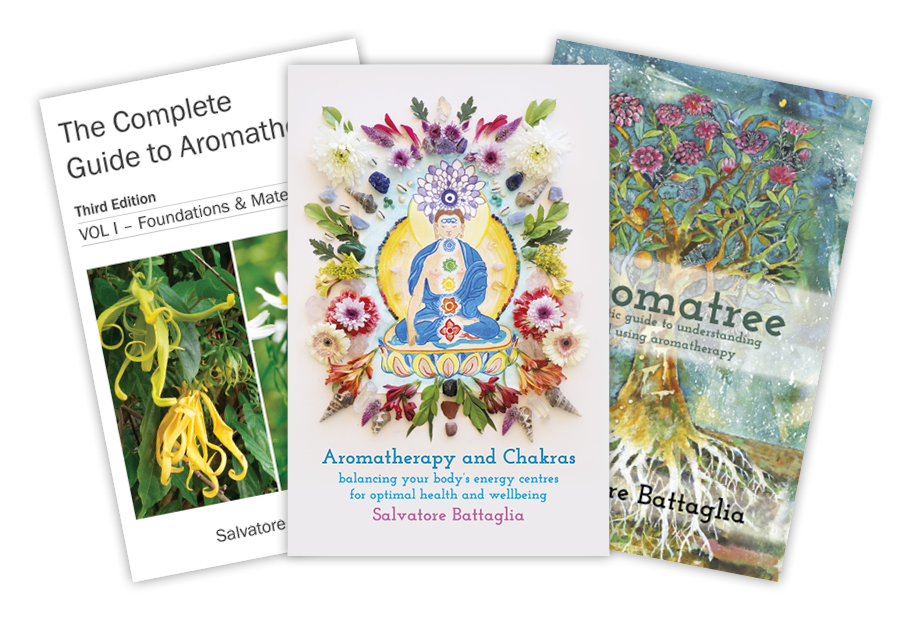The most beautiful thing we can experience is the mysterious. It is the source of all true art and science. He to whom the emotion is a stranger, who can no longer pause to wonder and stand wrapped in awe, is as good as dead —his eyes are closed.
Albert Einstein
A recent walk through the beautiful pine forests of Mount Kurama, near Kyoto, up to the Shinto shrine at the top of the mountain was most definitely awe-inspiring and provided the perfect inspiration for my Aromatherapy and Sacred Spaces Workshop. It is most appropriate that the first ever workshop be held in Japan. I could be patronizing and say that the Japanese invented the concept of sacred space. All humankind, in particular, those cultures that still maintain a deep connection with nature, embrace the importance of sacred spaces. However, if you have been to Japan, I am sure you will appreciate my comment. I must make a disclaimer – I visit Japan frequently and I always stay in Kyoto. I am sure there are more temples and shrines in Kyoto than any other city in Japan.
So exactly what do we mean by ‘sacred’? Most definitions of the word ‘sacred’ relate to spirituality and religion:1
- feelings of awe and mystery, an experience of something ‘wholly other’
- appropriated or dedicated to a deity or some religious purpose; consecrated.
- entitled to veneration or religious respect by association with divinity or divine things; holy.
- regarding with reverence
- reverently dedicated to some person or object.
A common underlying theme is a connection with religion or a ‘connection with God or a god or dedication to a religious purpose and so deserving veneration’.
When you do an online search for the meaning of ‘sacred space’ most of the academic articles focus on architecture, examining the elements of a building that make it sacred. Some focus on sacred places or sites around the world, examining the geographical elements that make the site sacred, while others focused on indigenous spiritual practices that often espouse an awe of nature.
I was excited to read one article suggesting that in order for a space to be considered sacred all our senses need to be engaged. It is not surprising that scent has always played an important role in defining a sacred space in so many cultures and spiritual practices. I also found many articles examining sacred spaces with reference to the Shinto religion of Japan. It was even suggested that Japan’s traditional Shinto beliefs could hold the solution to solving many of the environmental and social problems that we are currently dealing with in Western society.2
Aike Rots, author of The Rediscovery of ’Sacred Space’ in Contemporary Japan: Intrinsic Quality or Discursive Strategy? examines the meaning of sacred places within Japanese culture. Rots explains that while the concept of religion and sacred are often used as synonyms, the two do not completely overlap. Rots therefore asks, but what is it then that constitutes sacredness? He explains that theories of sacred can be divided into two types – those of ontological nature and those of a cultural sociological nature.2
Those of an ontological nature refers to the metaphysical, a feeling of awe and mystery, and experience of something ‘wholly other’. This feeling may be brought on by an external object, the mystical or divine, to which the individual reacts. On the other hand, the cultural sociological interpretation of sacred implies a unified set of beliefs and practices which unit one single moral community.2
It has been suggested that exposure to Western elements has led to a decline in spirituality within contemporary Japanese society; however, attempts have been made to reintroduce sacred places prominently within the Japanese cultural imagination.2
Rots cites Japanese philosopher and cultural theorist, Umerhara Takashi who states:
… the essence of Japanese religiosity and culture can be found in the way of living of the primordial ancestors of the Japanese nation: the people of the prehistorical Jomon period, who supposedly lived in harmonious coexistence with, and worshipped the ancestral spirits dwelling in, the forest (and, by extension, nature as a whole). He called this essence ‘animism’ which he describes as ‘the thought that says animals, plants and even inorganic things have a spirit that is connected to humans; and that, through this spirit, all living things can live …. [It] is the thought that sees the spirits dwelling in and bringing to life places in nature.2
According to Umerhara this is the core essence of Japanese spirituality and the appreciation of scared space is a core characteristic of Japanese religion. Rots states that Umehara is critical of the ‘monotheistic’ Western attitude that suggests it is humankind’s role to conquer and exploit nature which has led to widespread environmental destruction, global warming and an erosion of traditional values. Umehara suggests that animism may be the only way to overcome the current crisis. He explains that it should be the mission of Japan to save humankind by spreading its animistic ideas:
During the past 300 years, the West has built an abundant world based on the domination of nature by thinking man. For most of that period, non-Western man – “the other” – was also subjugated. But the West’s abundance is now threatened by the limits of nature to absorb the consequences of its plunder and by the resurgence, particularly in Asia, of prosperous and competitive non-Westerners. … Today, Japan’s goal should be to create another amalgamation – a new civilization – that blends the civilisation introduced from Europe with the Japanese native culture of the forest.2
I believe that we are facing a spiritual crisis simply because we have allowed ourselves to become so disconnected from nature. It is no wonder that aromatherapy has become so popular. Essential oils reintroduce nature into our often sterile life, devoid of any contact with nature.
The very first line of the third edition of The Complete Guide to Aromatherapy begins with a question – Why are people drawn to aromatherapy?3
I found the answer to my question in a very insightful comment by Suzanne Fisher-Rizzi who states that essential oils have the ability to cast a magical spell on our psyche:
Getting to know these heavenly scents is something like falling in love. They will touch your heart, making you keenly aware of the beauty surrounding you, and open the door to your soul. Suddenly, every facet of your life is touched by magic.4
She goes on to explain that essential oils can open the door to our soul:
… essential oils invite one to appreciate the beauty and wonders of creation, providing us inner contentment. As a gate to our soul, essential oils give us the impetus to search for meaning in our lives.4
I don’t know about you, but this is telling me that when you use essential oils, you are inviting the sacred into your life – that essential oils inspire a sense of awe. In preparing for the workshop in Japan I am always trying to find the right word that could be translated into Japanese. This word was awe.
We are often in awe when we visit a sacred place. I was so surprised how powerful the emotion of awe is, and the implications it can have on our health and wellbeing. I was also surprised that there has been so much research examining awe as an emotion. Keltner and Haidt define awe as the sensation of being in the presence of something vast that simultaneously transcends one’s understanding of the world: a state of being that straddles the boundary of pleasure and fear.5
Stone suggests that awe-inducing moments can be transformative and instigate personal growth.6
Experiences that arouse awe can help us to reconceptualise our sense of self, our role on society and from a more cosmic perspective, our place in the universe.6
Research suggests that individuals who reported experiencing awe more often in their daily lives were rated humbler by their friends. After participants experienced awe as part of a study, they acknowledged strengths and weaknesses in a more balanced way and they were more likely to recognise the role of outside forces in their personal accomplishments.7
Researchers have also found that those individuals who experienced more awe have better immune health. Awe was identified as the single positive emotion linked to lowering proinflammatory cytokines on a chronic basis.7
Another study took a group of military veterans and a group of youth on a white-water rafting trip to study the effect of nature (which people commonly report feeling in awe of) on the wellbeing of those individuals. For everyone, symptoms of PTSD went down, while scores of general happiness, satisfaction with life, social wellbeing, and how connected people felt with their community.7
This same article then goes on to explain how we may experience more awe every day. Not surprising that number one on the list was to go out into nature. Research has found that people consistently rank nature as one of the top ways that we can experience awe. It is not surprising that other advice for feeling more awe included to engage with the world with a more open mind, seeing possibilities, ask questions, and look for the impossible.7
Kelter describes awe as the feeling of being in the presence of something vast that transcends our understanding of the world. Historically, awe was reserved for feelings toward divine beings. He is concerned that our culture is becoming awe-deprived.8
Adults spend more and more time working and commuting and less time outdoors and with other people. So often our gaze is fixed on our smartphones rather than noticing the wonders and beauty of the natural world or witnessing acts of kindness, which also inspire awe. Attendance at art events – live music, theatre, museums and galleries – has dropped in recent years. This goes for children, too: arts and music programs in schools are being dismantled; time spent outdoors and for unstructured exploration are being sacrificed for resume-building activities. At the same time, our culture has become more individualistic, more narcissistic, more materialistic, and less connected to others.8
He suggests that in facing these big cultural challenges we may feel that our individual actions seem meaningless; however, research on awe suggests that modest steps can have a major impact on our wellbeing. He explains that we should nurture our own hunger of awe, be it through appreciating the trees in our neighbourhood, a beautiful piece of music, patterns of wind on water and the person who presses on against all odds. He states that not only will we feel better for experiencing awe, but our feelings of awe will also ripple out through acts of kindness.
Why does it not surprise me that researchers are suggesting excursions into nature to activate a sense of awe that also promotes health and wellbeing.9
Schnaubelt suggests that the willingness to embrace aromatherapy may also be a response to humanity’s deep desire to reconnect with nature.10
Schnaubelt also expresses discontent with modern society:
Society is not only distinguished by high mobility, flexibility, freedom and an abundance of ideas and innovative concepts, but also by a high degree of inequality, hyper-materialism, crime, violence, a constant rise in psychological disorders, and a drug subculture out of control.10
He explains that quiet connection to nature, holistic health and happiness and many other factors contributing to wellbeing are in short supply; however, aromatherapy provides us with great potential for physical healing and psychological regeneration.10
Aromatherapy provides us with a sacred space. Sacred spaces are places of refuge, quiet retreats for renewal, sanctuaries for our senses. They can be places where we can escape the pressures of the day. They are healing and comforting and cultivate a sense of spiritual renewal, harmony, and balance. Essential oils can evoke powerful emotions, awaken long lost memories, arouse feelings of our favourite sacred spaces, and reconnect us with the sacredness found in nature.
In the next blog post, I explain how essential oils can reintroduce the sacred into our daily lives. I will share with you my twelve favourite sacred space essential oils and we will investigate comments by Aike P. Rots who challenges the notion of Japanese culture that is characterised by a profound love of nature.
By the way – which essential oil or oils leave you feeling in awe?
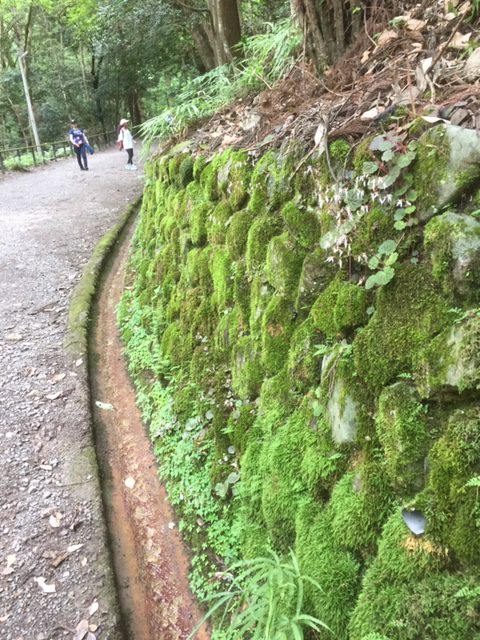
Moss in Japan
I have a fascination with moss and in Japan – it grows everywhere.
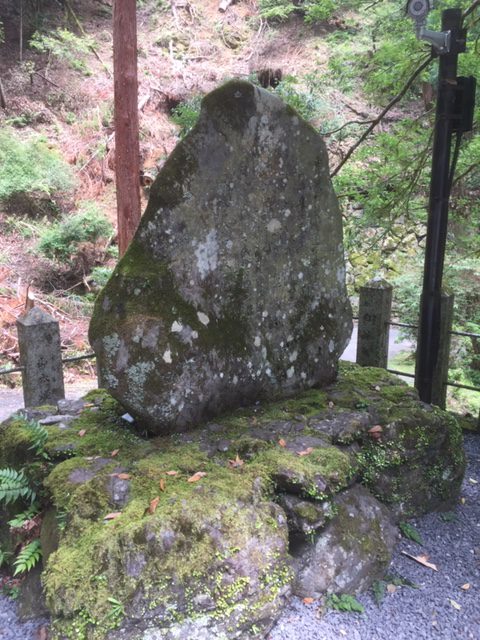
Stone Monument
A simple stone monument at the entrance of the temple. I was simply in awe of its simplicity and beauty.

Forest Spirit
This tree is home to a forest spirit. The tree is over 800 years old – certainly a very wise tree spirit lives in it.
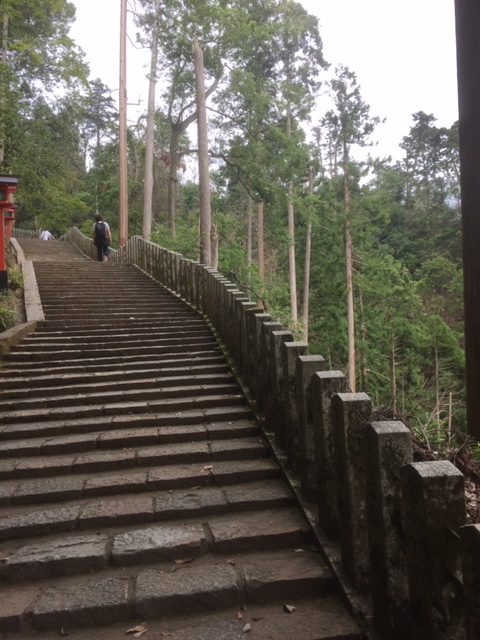
Walk to the Temple
The temple is at the top of the mountain. It is a steep 1,000+ metre walk to the temple.
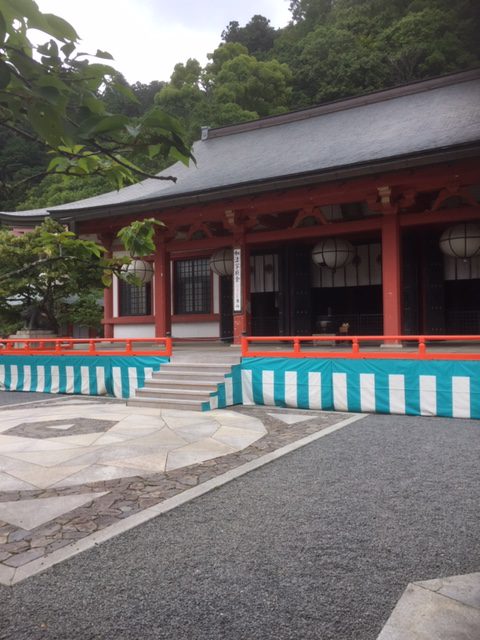
Temple Mt Kurama
The beautiful temple at the top of Mt Kurama.
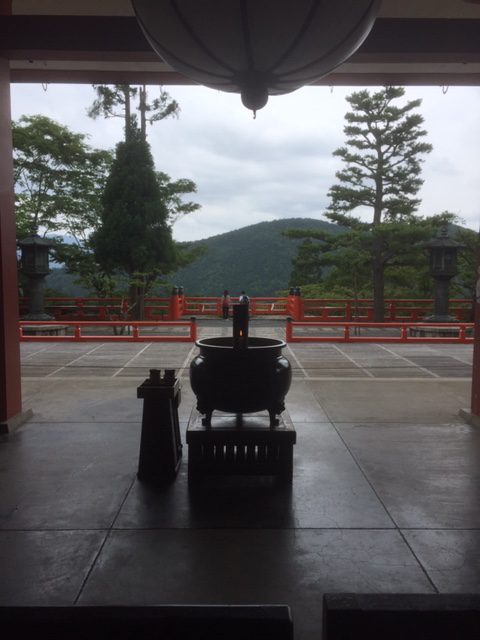
Looking Out
The outlook from inside the temple is spectacular – reflecting a deep respect and reverence to nature.

Japan the Paradox
I often call Japan a paradox – a fusion of the old and new. When you get to the top of the mountain – no way – there is a drink vending machine. You will never die of thirst in Japan!

New Friends
I became friends with two very “genki” guys on their way back from their annual pilgrimage to Mt. Kurama. N.B genki means healthy.
References
-
- Macquarie Dictionary – Australia’s National Dictionary. Third edition, The Macquarie Library, 1981.
- Rots AP. The Rediscovery of ’Sacred Space’ in Contemporary Japan: Intrinsic Quality or Discursive Strategy? Downloaded on 21 June 2019 from http://doi.org/10.15055/00001113
- Battaglia S. The Complete Guide to Aromatherapy. Third Edition, Black Pepper Creative, Brisbane, 2018.
- Fischer-Rizzi S. Complete Aromatherapy Handbook. Sterling Publishing, New York, 1990.
- Kelter D, Haidt J. Approaching Awe, A Moral, Spiritual, and Aesthetic Emotion. 2003;17:2;297-314. doi:10.1080/02699930302297
- Stone E. The Emerging Science of Awe and its Benefits. Downloaded on 23 June 2019 from https://www.psychologytoday.com.us/blog/understanding-awe/201704/the-emerging-science-awe-and-its-benefits
- DiGiullo S. Why Scientists Say Experiencing Awe Can Help You Live Your Best Life. Downloaded 23 June 2019 from https://www.nbcnews.com/better/lifestyle/why-scientists-say-experiencing-awe-can-help-you-live-your-ncna961826
- Keltner D. Why Do We Feel Awe? Downloaded on 23 June 2019 from https://greatergood.berkeley.edu/article/item/why_do_we_feel_awe
- Mikulak A. All About Awe. Downloaded 23 June 2019 from https://www.psychologicalscience.org/observer/all-about-awe
- Schnaubelt K. Medical Aromatherapy. Frog, Berkeley, 1999.

